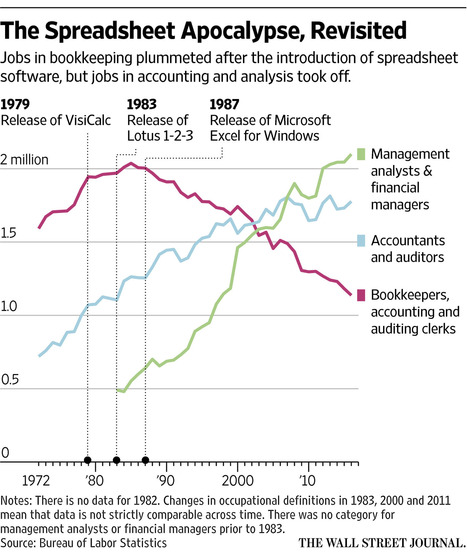(p. A8) For companies, choosing the appropriate tasks to automate is important. Auto maker BMW AG automated some of the physical labor at the Spartanburg plant in South Carolina while retaining tasks involving judgment and quality control for workers.
Robots fit black, soundproofing rubber tubes to the inner rim of car doors, a task once done entirely by hand, on the more than 5,000 or so car doors that pass through the production line each day. Human workers do final checks on the tube’s placement. The division of labor speeds up the process.
Since BMW introduced this and other automated processes over the past decade, it has more than doubled its annual car production at Spartanburg to more than 400,000. The workforce has risen from 4,200 workers to 10,000, and they handle vastly more complex autos–cars that once had 3,000 parts now have 15,000.
Being spared strenuous activities gives workers the time and energy to tackle more demanding and creative tasks, BMW said in a statement.
James Bessen, an economist who teaches at Boston University School of Law, said automation like that at the Spartanburg plant has enabled a huge increase in the quality and variety of products, which help spur consumer demand. BMW’s share of luxury-car sales in the U.S. has risen sharply, with over 300,000 cars sold last year compared with just over 120,000 in 1997, company figures show.
Tesla Inc., by contrast, has struggled with production of the Model 3 car at its Fremont, Calif., plant after its use of robots got out of balance. Undetected errors in parts built by robots caused bottlenecks in production, meaning it could build only 2,020 cars a week compared with the 5,000 it originally promised, according to the company.
Analysts at investment research firm Bernstein said Tesla automated welding, paint and body work processes, as other manufacturers have done, but also automated final assembly work, in which parts, seats and the engine are installed in the car’s painted shell. Errors in this work caused production bottlenecks. “Automation in final assembly doesn’t work,” said analyst Max Warburton.
“Yes, excessive automation at Tesla was a mistake…Humans are underrated,” wrote Tesla CEO Elon Musk in a tweet last month.
. . .
At an aggregate level, however, the jobs created by automation outnumber those that are being destroyed, according to analysis by the Massachusetts Institute of Technology’s David Autor and Utrecht University’s Anna Salomons.
For the full story, see:
William Wilkes. “Big Companies Fine-Tune The Robot Revolution.” The Wall Street Journal (Tuesday, May 15, 2018): A1 & A8.
(Note: ellipsis between paragraphs, added; ellipsis internal to paragraph, in original.)
(Note: the online version of the story has the date May 14, 2018, and has the title “How the World’s Biggest Companies Are Fine-Tuning the Robot Revolution.”)
More of James Bessen’s views on these issues, can be found in his discussion of ATMs in:
Bessen, James. Learning by Doing: The Real Connection between Innovation, Wages, and Wealth. New Haven, CT: Yale University Press, 2015.
The analysis by Autor and Salomons, mentioned above, appears in:
Autor, David, and Anna Salomons. “Is Automation Labor-Displacing? Productivity Growth, Employment, and the Labor Share.” In Brookings Papers on Economic Activity, Feb. 27, 2018.


